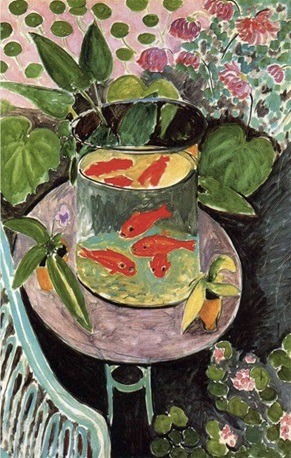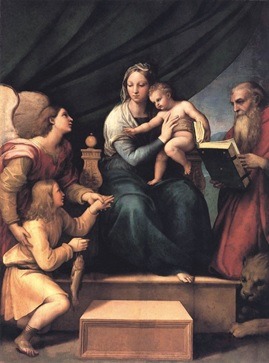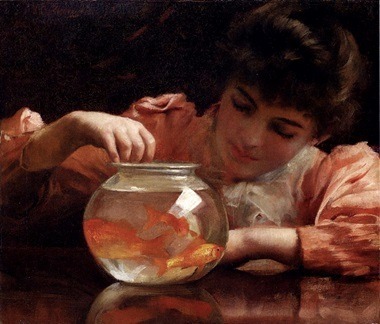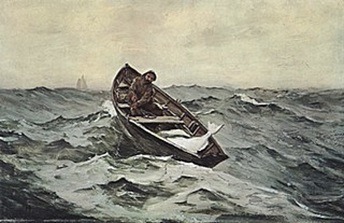Throughout civilization, “The Fish” has always been a prominent symbol in one form or another. To the Celts, they represented wisdom. To the Greeks, they meant fertility. To Christians, they symbolized humanity and divinity, and in Asia, the fish represents many things, such as wealth, prosperity, luck, and abundance.
In the realm of art, fish have also been a recurring topic of interest and feature throughout the ages. Many famous painters have found themselves enamored with the creatures for their surface beauty and symbolic meaning.
It could even be argued that fish are the most well-known and widely regarded animal worldwide. Many cultures rely almost entirely on fish for their survival. As life itself is believed to have originated from the water, fish could be seen as the most critical symbol concerning the evolution of humankind.
Madonna with the Fish by Raphael
Madonna with the Fish is a beautiful High Renaissance painting painted in 1512 by Italian master Raffaello Sanzio, or simply Raphael. Praised for the visual beauty of his artwork, the fish artist is regarded as one of the trinity of great masters of the period, alongside Michelangelo and Leonardo Da Vinci.
Madonna with the Fish depicts a scene of the Virgin Mary holding the baby Jesus in her arms. St. Jerome and his lion surround the pair, and on the other side are the archangel Raphael and the young boy Tobias holding a fish.
The fish that Tobias holds represents baptism, and a religious water ceremony said to wash away sins and purify the spirit, thus bringing forth salvation and overcoming death. Interesting to note that Jesus himself would also be symbolized as a fish and would come to represent resurrection and immortality.
Goldfish by Henri Matisse
Goldfish is a unique, post-impressionist painting by French artist Henri Matisse. Goldfish were introduced into Europe from Asia during the late 17th century and would become a recurring theme in the work of Matisse, arguably making him the most fantastic fish artist.
He created nine pieces featuring fish, but his painting entitled “Goldfish” was the only one that had them as the central focus. Matisse felt that goldfish held a hypnotic quality to them when watched from their fishbowls and thus made for an excellent topic for a painting.
Although highly stylized and vibrantly colored, the painting itself, which are staples of Post-Impressionism, also has a somewhat child-like quality that significantly adds to its charm. The bold colors blend beautifully, resulting in a warm and inviting painting that irresistibly attracts the viewer’s eye and attention.
Idle Hours by Thomas Benjamin Kennington
Idle Hours is a charming piece of art painted by British portrait painter Thomas Benjamin Kennington in 1892. He specialized in paintings of social realism, which depicted scenes of everyday life with an undercurrent of the harsh realities of life.
One of his finest paintings of this manner is his painting titled “Idle Hours”. It conveys a humble scene of a young woman gazing upon three goldfish swimming in a fishbowl while gently caressing the bowl’s rim with her hand.
The realism of the piece is exquisite, as you can practically feel the idle emotions emanating from the girl in the painting. Moreover, an existential tone of the sadness and boredom often associated with everyday life can also be felt as you get lost in Kennington’s painting’s beauty.
The Fog Warning by Winslow Homer
The Fog Warning is a realistically gloomy seascape painting by American Historical artist Winslow Homer. Winslow is best known for his artwork on marine subjects, and The Fog Warning is just one of three pieces he painted in the year 1885 depicting the harsh lives of the fisherman on the North Atlantic coast of America.
This gripping painting depicts the scene of a lone fisherman caught on rough seas as the grey fog of a storm creeps ever closer. His face is turned in the direction of the menacing clouds as he attempts to race back to his main ship out on the horizon before the storm can reach him.
The painting’s narrative is a rather disturbing one and ultimately portrays the harness of life. The fisherman has been successful in his catch, and his boat is full of fish. However, his most challenging task is still ahead of him. The tension and real-life danger present here is palpable as you ask yourself, will he reach his ship in time or be lost at sea forever?
Koi Fish Paintings by Various Artists
Finally, let’s look at some of the most revered and reproduced fish paintings. Throughout Asia, the Koi fish is such a prolific and prominent symbol in the arts that it is nearly impossible to pick just one fish painting. Instead, there has been an honored tradition of depicting these beautiful creatures on canvas for hundreds of years.
In Chinese culture, the Koi fish is believed to be a powerful symbol of positive energy and abundance. This is because the Koi fish can successfully swim upstream. For this reason, the fish is said to be one of the most popular and potent means of attracting the energy of wealth.
The Koi fish is also said to be associated with good luck. In Chinese and Japanese traditions, the Koi fish will often be painted in groups of seven or eight. In China, the digit eight is associated with prosperity, while the number seven is regarded as a lucky number in Japanese and Buddhist culture.
The Bottom Line
Of the countless themes and topics that reoccur in art, perhaps none are more powerful yet underrated than those involving fish. The subject has enticed many masters, and maybe now you have also been tempted in their wake.




